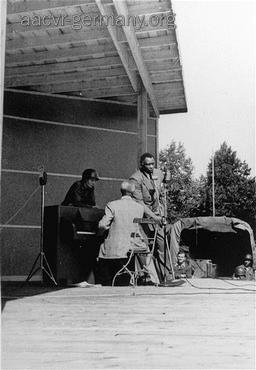Liberation of the Camps
Upon seeing with their own eyes the carnage that Nazi anti-Semitism and racism had brought about, African-American GIs were stunned beyond belief. They, just like white GIs, had to come to terms with the sheer scope of Nazi racial persecution and the complacency of the German people. The horrifying sights of dead and tortured bodies and the encounters with the emaciated and broken survivors of the Nazi death camps touched African Americans on a particularly personal level.
The Double-V Campaign, demanding democratic victory at home and abroad, had often drawn upon the parallels between racial persecution in Nazi Germany and the Jim Crow South to expose the discrepancy between the struggle for democracy abroad and the continuing discrimination of African Americans at home.
Indeed, African-American activists had often drawn parallels between the racial persecution of the Jews and that of Blacks under Jim Crow. Faced with the realities of the Holocaust, African-American GIs such as William A. Scott, a member of the 183rd Engineer Combat Battalion, thus evaluated their experiences in Germany in light of their own struggles in the U.S. Scott, depicted in several images displayed below, stated that, “even though my ancestors had arrived [in America] as slaves in chains from Africa, and [were] subjected to torture and death during the long centuries of slavery, it all seemed to pale in comparison to the glaring impact of what I had witnessed in Buchenwald.” (William A. Scott, Booklet, USHMM)
Further Reading
For a list of publications on African Americans and the Holocaust please see here.
“Gert Schramm: Der Schwarze, der Buchenwald überlebte” (Süddeutsche Zeitung, June 5, 2009).
For testimonies by African American liberators of concentration camps available at the United States Holocaust Memorial Museum (USHMM) in Washington, DC please click here.











